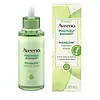What's inside
What's inside
 Key Ingredients
Key Ingredients

No key ingredients
 Benefits
Benefits

 Concerns
Concerns

 Ingredients Side-by-side
Ingredients Side-by-side

Water
Skin ConditioningGlycerin
HumectantButylene Glycol
HumectantBis-PEG-18 Methyl Ether Dimethyl Silane
EmollientPentaerythrityl Tetraethylhexanoate
EmollientIsodecyl Neopentanoate
EmollientPhenoxyethanol
PreservativeEthylhexylglycerin
Skin ConditioningAmmonium Acryloyldimethyltaurate/Vp Copolymer
Chlorphenesin
AntimicrobialDimethicone
EmollientYeast Extract
Skin ConditioningSuccinoglycan
Skin ConditioningParfum
MaskingActinidia Chinensis Fruit Water
MaskingGlycine Soja Seed Extract
Skin ConditioningAcrylates/C10-30 Alkyl Acrylate Crosspolymer
Emulsion StabilisingCitrus Limon Peel Extract
EmollientDimethiconol
EmollientSodium Hydroxide
BufferingWater, Glycerin, Butylene Glycol, Bis-PEG-18 Methyl Ether Dimethyl Silane, Pentaerythrityl Tetraethylhexanoate, Isodecyl Neopentanoate, Phenoxyethanol, Ethylhexylglycerin, Ammonium Acryloyldimethyltaurate/Vp Copolymer, Chlorphenesin, Dimethicone, Yeast Extract, Succinoglycan, Parfum, Actinidia Chinensis Fruit Water, Glycine Soja Seed Extract, Acrylates/C10-30 Alkyl Acrylate Crosspolymer, Citrus Limon Peel Extract, Dimethiconol, Sodium Hydroxide
Water
Skin ConditioningC12-15 Alkyl Benzoate
AntimicrobialCoconut Alkanes
EmollientGlycerin
HumectantPolyglyceryl-10 Mono/Dioleate
Skin ConditioningPolyglyceryl-3 Oleate
EmulsifyingPhosphatidylglycerol
Coco-Caprylate/Caprate
EmollientAnhydroxylitol
HumectantXylitol
HumectantXylitylglucoside
HumectantGlucose
HumectantEuterpe Oleracea Sterols
Skin ConditioningLinoleic Acid
CleansingLinolenic Acid
CleansingOleic Acid
EmollientSodium Hyaluronate
HumectantPhenoxyethanol
PreservativeEthylhexylglycerin
Skin ConditioningTocopheryl Acetate
AntioxidantSorbitan Isostearate
EmulsifyingXanthan Gum
EmulsifyingHydroxyethyl Acrylate/Sodium Acryloyldimethyl Taurate Copolymer
Emulsion StabilisingCetyl Hydroxyethylcellulose
Emulsion StabilisingDisodium Phosphate
BufferingHydrated Silica
AbrasiveSilica Dimethyl Silylate
EmollientSodium Phosphate
BufferingSodium Benzoate
MaskingAllantoin
Skin ConditioningArnica Montana Flower Extract
MaskingCaprylyl Glycol
EmollientPotassium Sorbate
PreservativeHexylene Glycol
EmulsifyingAcer Saccharum Sap
HumectantCitric Acid
BufferingSodium Phytate
Pentylene Glycol
Skin ConditioningSodium Acetylated Hyaluronate
HumectantSodium Hyaluronate Crosspolymer
HumectantHydrolyzed Sodium Hyaluronate
Skin ConditioningCarbomer
Emulsion StabilisingCeramide AP
Skin ConditioningCeramide EOP
Skin ConditioningCeramide NP
Skin ConditioningCholesterol
EmollientPhytosphingosine
Skin ConditioningSodium Lauroyl Lactylate
EmulsifyingWater, C12-15 Alkyl Benzoate, Coconut Alkanes, Glycerin, Polyglyceryl-10 Mono/Dioleate, Polyglyceryl-3 Oleate, Phosphatidylglycerol, Coco-Caprylate/Caprate, Anhydroxylitol, Xylitol, Xylitylglucoside, Glucose, Euterpe Oleracea Sterols, Linoleic Acid, Linolenic Acid, Oleic Acid, Sodium Hyaluronate, Phenoxyethanol, Ethylhexylglycerin, Tocopheryl Acetate, Sorbitan Isostearate, Xanthan Gum, Hydroxyethyl Acrylate/Sodium Acryloyldimethyl Taurate Copolymer, Cetyl Hydroxyethylcellulose, Disodium Phosphate, Hydrated Silica, Silica Dimethyl Silylate, Sodium Phosphate, Sodium Benzoate, Allantoin, Arnica Montana Flower Extract, Caprylyl Glycol, Potassium Sorbate, Hexylene Glycol, Acer Saccharum Sap, Citric Acid, Sodium Phytate, Pentylene Glycol, Sodium Acetylated Hyaluronate, Sodium Hyaluronate Crosspolymer, Hydrolyzed Sodium Hyaluronate, Carbomer, Ceramide AP, Ceramide EOP, Ceramide NP, Cholesterol, Phytosphingosine, Sodium Lauroyl Lactylate
 Reviews
Reviews

Ingredients Explained
These ingredients are found in both products.
Ingredients higher up in an ingredient list are typically present in a larger amount.
Ethylhexylglycerin (we can't pronounce this either) is commonly used as a preservative and skin softener. It is derived from glyceryl.
You might see Ethylhexylglycerin often paired with other preservatives such as phenoxyethanol. Ethylhexylglycerin has been found to increase the effectiveness of these other preservatives.
Glycerin is already naturally found in your skin. It helps moisturize and protect your skin.
A study from 2016 found glycerin to be more effective as a humectant than AHAs and hyaluronic acid.
As a humectant, it helps the skin stay hydrated by pulling moisture to your skin. The low molecular weight of glycerin allows it to pull moisture into the deeper layers of your skin.
Hydrated skin improves your skin barrier; Your skin barrier helps protect against irritants and bacteria.
Glycerin has also been found to have antimicrobial and antiviral properties. Due to these properties, glycerin is often used in wound and burn treatments.
In cosmetics, glycerin is usually derived from plants such as soybean or palm. However, it can also be sourced from animals, such as tallow or animal fat.
This ingredient is organic, colorless, odorless, and non-toxic.
Glycerin is the name for this ingredient in American English. British English uses Glycerol/Glycerine.
Learn more about GlycerinPhenoxyethanol is a preservative that has germicide, antimicrobial, and aromatic properties. Studies show that phenoxyethanol can prevent microbial growth. By itself, it has a scent that is similar to that of a rose.
It's often used in formulations along with Caprylyl Glycol to preserve the shelf life of products.
Water. It's the most common cosmetic ingredient of all. You'll usually see it at the top of ingredient lists, meaning that it makes up the largest part of the product.
So why is it so popular? Water most often acts as a solvent - this means that it helps dissolve other ingredients into the formulation.
You'll also recognize water as that liquid we all need to stay alive. If you see this, drink a glass of water. Stay hydrated!
Learn more about Water